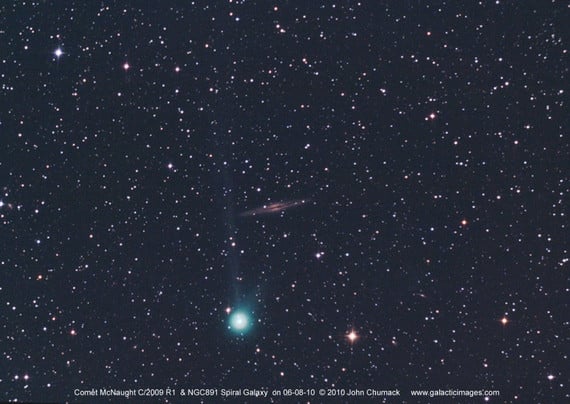[/caption]
A new comet with the familiar name of McNaught has just begun to grace the morning skies in the Northern Hemisphere, and it may provide observers a chance to see a naked-eye comet with a distinct tail. First images of McNaught C/2009 R1 show the tail shooting straight up into the sky, and this image was taken by amateur astronomer
John Chumack
from Ohio, who captured the comet passing by galaxy NGC 891 just before sunrise on June 8th. "I used a 5.5 inch telescope and a Canon Rebel Xsi digital camera to take this 15 minute exposure," Chumack said. "It also looked great through binoculars."
This is the latest comet discovered by Australian astronomer Robert H. McNaught, who spotted this new comet on September 9, 2009. One of the brightest comets of the past decade also bore McNaught's name, Comet McNaught,
(C/2006 P1).
The new Comet McNaught can be found low in the northeastern sky before dawn, now moving through the constellation Perseus. This coming weekend of Friday, June 11, through Sunday, June 13 should be a good time to look for the comet, as we have a New Moon on the 12th.
However, it will be brighter later next week, as it approaches Earth for a 1.13 AU close encounter on June 15th and 16th. Right now, the comet is right at the threshold of naked eye visibility (6th magnitude) and could become as bright as the stars of the Big Dipper before the end of the month.
Since this is the comet's first visit to the inner solar system, it is uncertain how bright it will get, but skywatchers should definitely take advantage of this opportunity.
The comet's atmosphere, or the gas expanding from the comet's nucleus is actually really huge -- estimated to be larger than the planet Jupiter, and that's what makes this one a possible naked-eye object.
In addition to the sky maps at
Astronomy Magazine
,
Heaven's Above
also has sighting times listed,
Sky & Telescope has another sky map,
NASA's Solar System Dynamics page has a listing for C/2009 R1,
and
Cosmos4U has a list of images from the new comet.
Thanks again to John Chumack for sharing his image!
Sources:
Astronomy Magazine, Spaceweather.com,
John Chumack's website, Galactic Images
,
The Miami Valley Astronomical Society
 Universe Today
Universe Today
